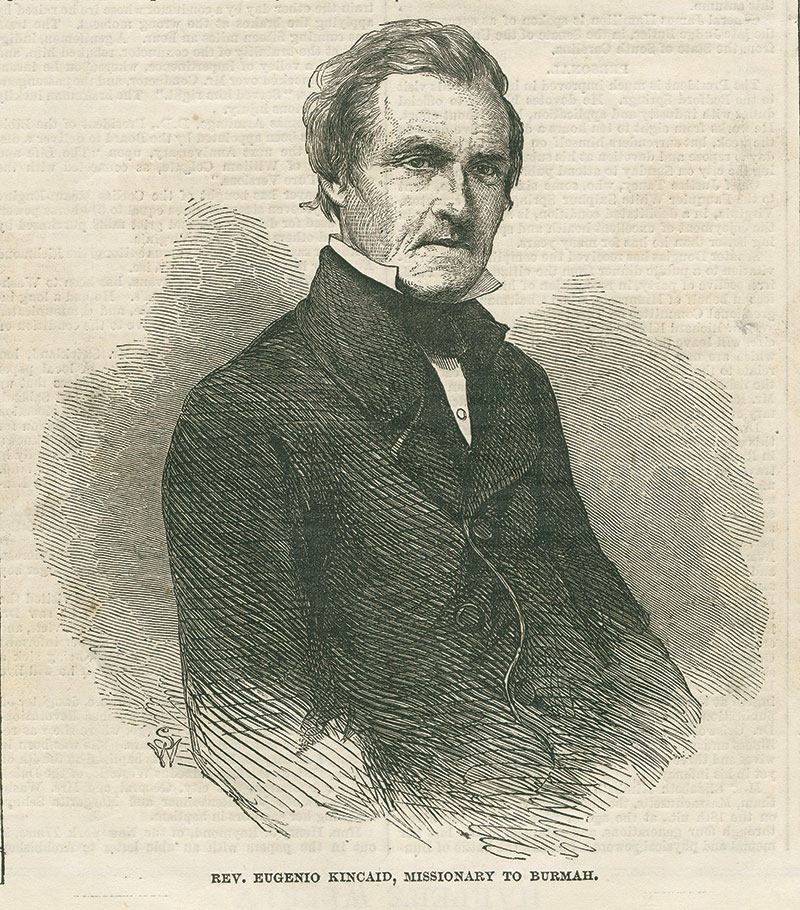
Portrait courtesy of
Special Collections and University Archives
Jan. 10, 1797 – April 3, 1883
The long road to what is now Colgate was decidedly different for Eugenio Kincaid compared to other alumni. Hailing from DeKalb, N.Y., he traveled on foot to Hamilton, walking 160 miles to the Baptist Education Society of the State of New York with a solitary goal: to study the word of God.
Kincaid wasn’t always drawn to the clergy, which was the only degree path available to students in the early days of the University. He was first a teacher in Pennsylvania, but after having conversations with a pastor at a Baptist church in DeKalb, he became a member of the congregation and decided to further study Christianity in Hamilton.
The trip south wasn’t an easy one for Kincaid. As he walked, he carried a handkerchief and 25 cents (about $5.96 today), relying on the money he’d made from chopping wood to pay for food and a warm bed. Kincaid is considered Colgate’s second student because he arrived on campus just after Jonathan Wade. Kincaid’s legacy cannot be separated from Wade, who was his classmate. In fact, as Jim Smith ’70 says in Becoming Colgate, they applied to the University together in what some might view as an admission essay. In that joint letter, they expressed their desire to help spread the gospel to Burma: “Our views and desires are the same: ‘To live and die in Burmah’ is our first and chief request of God…. To be engaged in this mission, is more to us, than the possession of wealth, the pleasures of friendship, or the honors of the world.”
Upon arrival in Hamilton, Daniel Hascall, one of Colgate’s founders and first teachers, knew of Kincaid’s impoverished state and said, “My boy, I will take you and we will do the best we can.” Early students studied privately with ministers before the school officially opened its doors; Kincaid learned about Latin with Hascall. Then, his education took place on the top floor of the Hamilton Academy on Broad Street, donated to the Baptist Education Society of the State of New York by the village of Hamilton for temporary use. There, Kincaid studied classical languages, rhetoric, and moral philosophy, a curriculum sometimes termed a “liberal education.”
After graduating from the University, Kincaid’s dream of becoming a Baptist missionary was realized. Domestically, he founded a church in Milton, Pa., then took his work abroad to Burma. He lived in the country for 27 years, during which he served as a partial diplomat, once helping to improve relations with the king of Burma and President James Buchanan.
Kincaid often came back to the United States to raise money for Baptist missionaries and lecture about his work overseas. He returned to campus to speak at an event during the 1843 commencement and Baptist missionary convention. With the chapel overflowing, guests gathered in a nearby ravine to listen to his address.
After a long life of spreading the gospel, Kincaid returned to the United States permanently in 1866 and settled in Girard, Kan. He died April 3, 1883, at the age of 86.
During one of his sabbaticals back in the United States, Kincaid became a trustee of Bucknell University (then called the University at Lewisburg), helping to raise $100,000 to start the institution.
